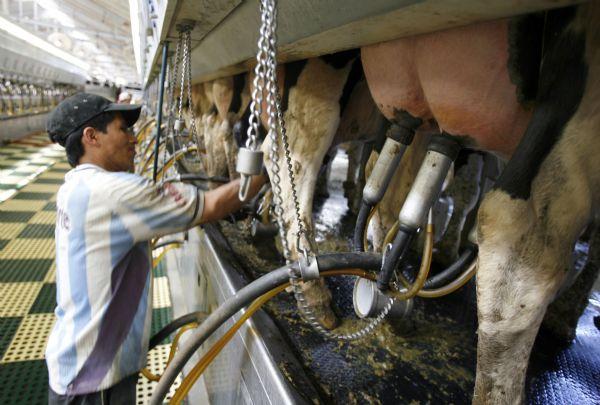This is an archived article that was published on sltrib.com in 2009, and information in the article may be outdated. It is provided only for personal research purposes and may not be reprinted.
The Agriculture Department is helping struggling dairies by raising the price paid for milk and cheddar cheese but the increase isn't enough to cover most operational costs, pushing farmers in Utah and elsewhere deeper into debt.
"It's better than a kick in the pants," said Elberta dairymen Brad Bateman of the boosts to the Dairy Product Price Support Program. "But it doesn't come close to helping dairy farmers cope with this crisis situation."
Last year, farmers increased production when demand for U.S. milk exports soared, but once the global recession hit, demand dropped and wholesale prices crashed.
Milk prices are at a 30-year low, forcing many farmers to shut down operations or borrow to keep them running, while burning up the equity in their land, animals and equipment. Bateman stands to lose 30 years of equity "within a single year."
Dairy farmers also have seen the value of that equity decline. A milk cow, for instance, was valued at about $2,000 last year, compared with around $1,000 today. With those kinds of losses, "there's no way the business to exist," said Bateman, who serves as president of the Western States Dairy Producers Trade Association, representing farmers in Utah and seven other states.
At the same time, operational costs continue to skyrocket. Bateman points to the 1970s cost of a tractor, which was about $40,000, and that of today, which has increased to nearly $300,000.
Last week, U.S. Agriculture Secretary Tom Vilsack said increases to the price-support program would provide immediate relief, helping keep producers on the farm while they weather what he called "one of the worst dairy crises in decades."
The price paid by dairy processors to farmers for their milk is set by the U.S. Department of Agriculture, based on commodity markets that rise and fall with global demand. The department estimates the temporary increases in price supports paid to farmers, which will be in place from August to October, will boost dairy farmers' overall revenue by $243 million.
The increase will raise the price paid for nonfat dry milk from 80 cents per pound to 92 cents, the price paid for cheddar blocks from $1.13 per pound to $1.31 and the price of cheddar barrels from $1.10 per pound to $1.28. These temporary increases will in turn will increase the price dairy farmers receive for their milk, said Vilsack.
In March, the Agriculture Department also tried to buoy wholesale prices by releasing 200 million pounds of excess powdered milk to schools, food banks and needy countries to reduce U.S. supply.
Chris Galen, a senior vice president with the National Milk Producers Federation, said the government actions "help but it's not a magic wand that will restore profitability to the industry." Overall, farmers are receiving $1 for every gallon of milk they produce, while operational costs are about $1.50 per gallon, he said.
In January the federation informed the Obama Administration that the dairy industry was on the brink of collapse. The administration, in turn, has raised dairy product prices higher than what the federation asked.
But some of the nation's 57,000 dairy farmers say the solution is to change the milk pricing system so that wholesale prices reflect what they pay for feed, fuel and other supplies. If successful, milk would be the only commodity to have a government-set price based on the cost of production.
That scenario troubles Elberta dairyman Bateman, who insists he does not want to advocate for more government intervention-- yet he sees no other alternative.
"There has to be an index of input costs, similar to what other businesses receive," he said. "Cheesemakers have allowances that are adjusted to offset their costs. Dairy producers don't get that kind of an offset, making it difficult to survive."
dawn@sltrib.com" Target="_BLANK">dawn@sltrib.com
Utah losing its dairy farms
Total number of Utah farms:
2007 » 530
2005 » 580
2000 » 830
1998 » 900
Source: Utah Department of Agriculture and Food.







